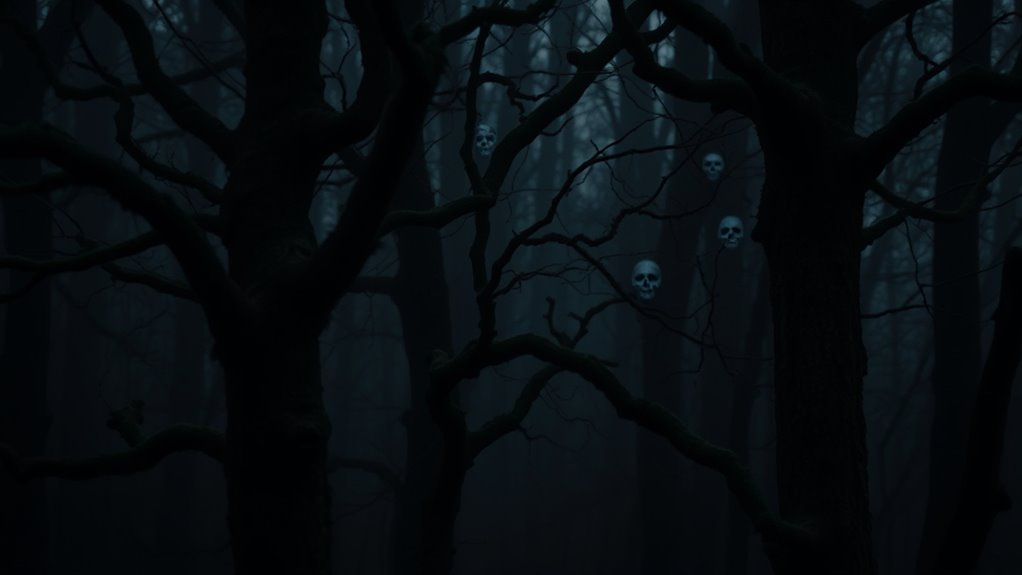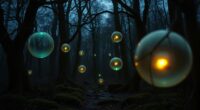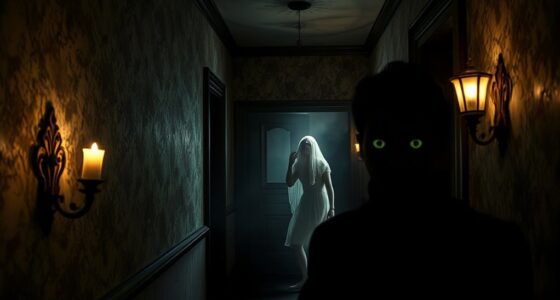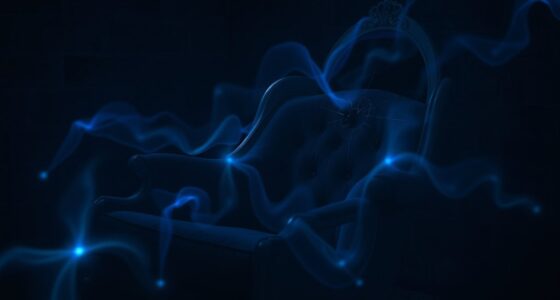When you see ghosts in shadows, your brain is quickly matching vague shapes to familiar patterns, like faces or figures. This tendency, called pareidolia, evolved to help detect threats or social cues fast. Shadows and unclear shapes often resemble faces or figures, triggering these recognition processes. Fear and imagination amplify these perceptions, leading you to see supernatural figures. If you want to understand why your mind makes these connections, there’s much more to explore.
Key Takeaways
- The brain’s pattern recognition quickly interprets ambiguous shadows as faces or figures due to neural pathways dedicated to social recognition.
- Shadows and low-light conditions enhance pareidolic perceptions by creating unfamiliar shapes that trigger the brain’s threat detection mechanisms.
- Evolutionarily, humans are wired to identify potential threats in shadows, leading to seeing ghosts or spirits as a survival instinct.
- Cultural beliefs and fears amplify the tendency to interpret shadow shapes as supernatural entities or ghosts.
- Sensory adaptation filters static shadows, making sudden or unusual shapes stand out as familiar faces or ghostly figures.
Understanding the Phenomenon of Pareidolia
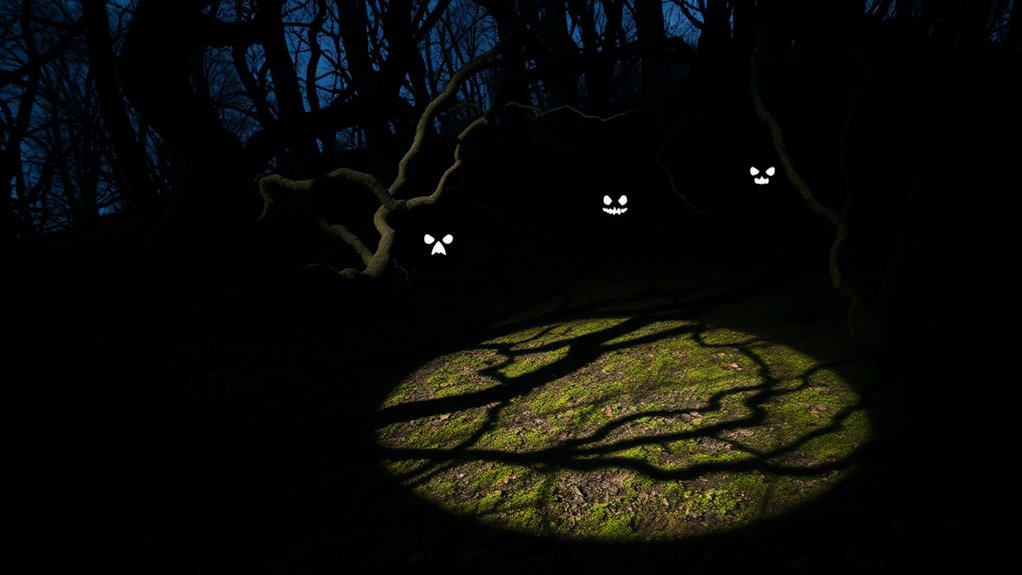
Pareidolia is the tendency to perceive familiar patterns, such as faces or objects, in random stimuli. Your brain’s neural mechanisms play a vital role in this process, rapidly matching sensory input with stored memories of familiar shapes. When you see a face in a cloud or on a piece of toast, it’s because your brain is wired to identify faces quickly, a trait rooted in neural pathways dedicated to social recognition. Cultural influences also shape what patterns you’re most likely to see. For example, people from different backgrounds may interpret ambiguous images differently, influenced by cultural symbols and experiences. This interplay between neural mechanisms and cultural influences explains why pareidolia is a universal yet highly subjective phenomenon, revealing how your brain and environment collaborate to create meaningful perceptions from chaos. Additionally, the presence of certain office plants in your environment can subtly influence your mood and perception, potentially affecting your susceptibility to pareidolia. Studies have shown that exposure to nature-inspired stimuli can enhance perceptual sensitivity and creativity. Engaging in mindfulness practices can also help you become more aware of when your perception is being influenced by cognitive biases, thereby reducing misinterpretations. For example, understanding perception mechanisms can help you recognize when your brain is filling in gaps with familiar patterns. Furthermore, engaging with dog training or other social activities can enhance your ability to interpret ambiguous stimuli more accurately, reducing misperceptions.
The Psychology Behind Seeing Faces in Shadows
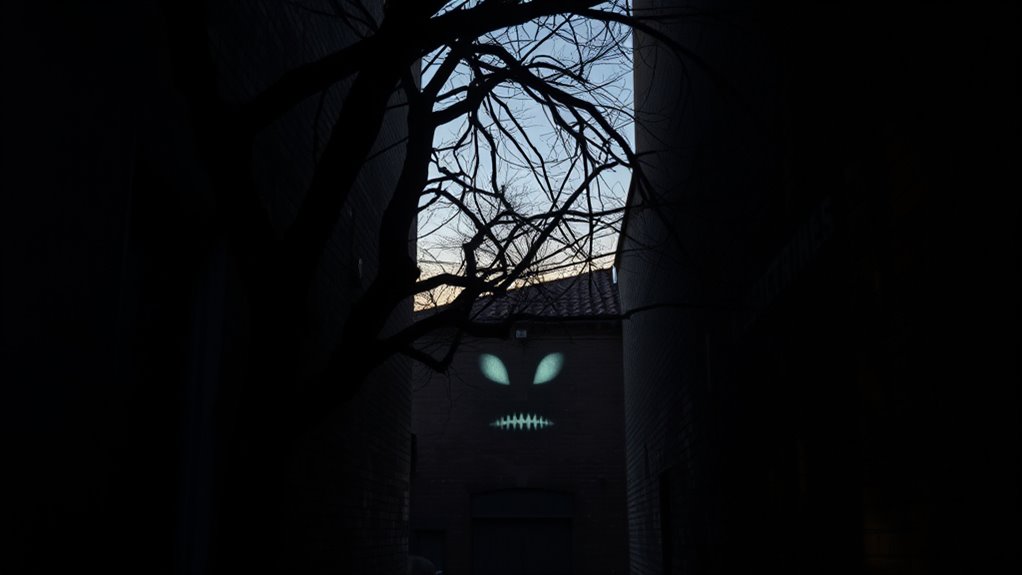
When your brain encounters ambiguous shapes like shadows, it instinctively searches for familiar patterns, often leading you to see faces where none exist. This tendency is rooted in psychological processes designed for quick recognition, especially of human faces. Cultural influences also shape what you perceive; for example, beliefs about ghosts or spirits can amplify these illusions. Your brain’s pattern recognition is influenced by past experiences and cultural conditioning, making certain shapes more likely to be interpreted as faces or supernatural entities. The table below highlights key factors in this process:
| Factor | Explanation | Impact on Perception |
|---|---|---|
| Pattern Recognition | Brain’s quick identification of familiar shapes | Leads to seeing faces in shadows |
| Cultural Beliefs | Cultural narratives about spirits or ghosts | Reinforces paranormal interpretations |
| Evolutionary Bias | Survival advantage in recognizing threats quickly | Heightens sensitivity to shadows |
| Ambiguity Tolerance | Comfort with uncertain stimuli | Encourages seeing faces in shadows |
Additionally, the brain’s perceptual shortcuts can sometimes lead to false positives, especially in low-light conditions. Recognizing these cognitive biases can help you understand why such illusions occur. Psychological research shows that the tendency to anthropomorphize ambiguous stimuli is a common feature of human perception. Understanding how personal beliefs influence perception can also shed light on why certain shadow figures are more readily attributed to supernatural sources. Moreover, the brain’s pattern recognition is particularly sensitive to low-contrast images, which can intensify these illusions.
Common Examples of Pareidolia in Everyday Life

You might notice familiar shapes in everyday objects, like faces in household items or animal forms in random objects. Cloud patterns often resemble people, animals, or faces, sparking your imagination. These recognizable forms are classic examples of pareidolia at work in your daily life. Interestingly, this tendency can be influenced by visual perception mechanisms, which help your brain interpret ambiguous images more easily. Additionally, contrast ratio plays a role in how clearly these images are perceived, especially in dim environments. The brain’s pattern recognition processes are fundamental to how we experience pareidolia, as they enable us to identify familiar shapes quickly. Moreover, visual cues such as shadows and lighting conditions can enhance or diminish these pareidolic perceptions, making the shapes more or less apparent. As AI models like GPT-4 evolve, their ability to recognize and interpret visual patterns can also be affected by these perceptual factors, highlighting the importance of understanding AI vulnerabilities in complex visual tasks.
Recognizable Object Forms
People often notice familiar shapes in everyday objects due to pareidolia, making ordinary items seem like recognizable figures or faces. For example, a face may appear in the pattern of a coffee stain or the grille of a car. This artificial recognition is influenced by our brain’s tendency to seek familiar forms, sometimes leading us to see animals or faces where none exist. Cultural influences also play a role; what looks like a face in one culture might be interpreted differently in another. These common examples show how our minds connect random patterns to familiar objects, creating a sense of recognition. Understanding these tendencies helps explain why everyday items often evoke strong perceptions of recognizable object forms, even when there’s no real intention behind them.
Cloud Shape Patterns
Clouds often serve as a canvas for pareidolia, where their irregular shapes resemble familiar objects or figures. You might see a face in a fluffy cloud or a dragon in a dark storm shadow. These cloud illusions play with shadow perception, making shapes seem more recognizable. Our brains naturally seek patterns, turning random formations into meaningful images. Utilizing natural materials and shapes in the sky, such as cloud formations, can evoke a sense of wonder or nostalgia. Here are some common examples:
| Shape | Cloud Type | Notable Illusion |
|---|---|---|
| Face | Cumulus | Smiling face in the sky |
| Animal | Lenticular | Flying bird or dragon |
| Object | Stratus | Boat or vehicle shape |
These illusions highlight how pareidolia transforms everyday sky views into stories or figures, engaging your imagination.
Evolutionary Reasons for Recognizing Faces in Ambiguous Stimuli
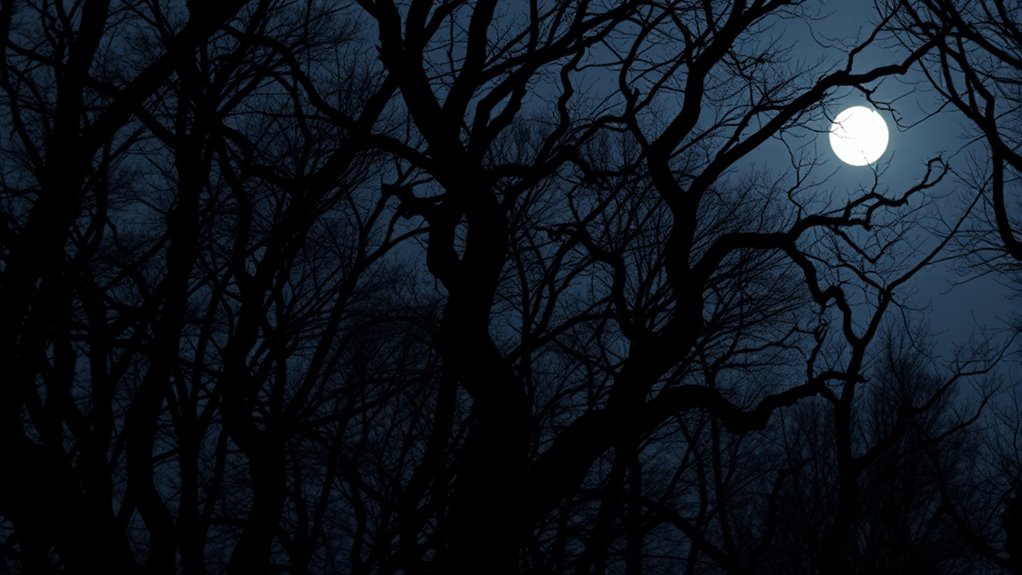
Recognizing faces in ambiguous stimuli offers clear evolutionary advantages by enabling early humans and other primates to identify friends, foes, and social allies quickly. This ability relies on specialized neural pathways in the brain that rapidly process facial features, even when the stimuli are incomplete or unclear. Sensory adaptation also plays a role, as your senses become attuned to familiar patterns, making it easier to detect faces amid shadows or irregular shapes. This quick recognition helps you respond appropriately—whether to seek safety or forge social bonds—enhancing survival chances. Over time, natural selection favored individuals with heightened sensitivity to facial cues, leading to the development of pareidolia as an adaptive trait. Recognizing faces in ambiguous stimuli therefore reflects an evolutionary strategy for social cohesion and threat detection.
How Our Brains Interpret Shadows and Shapes
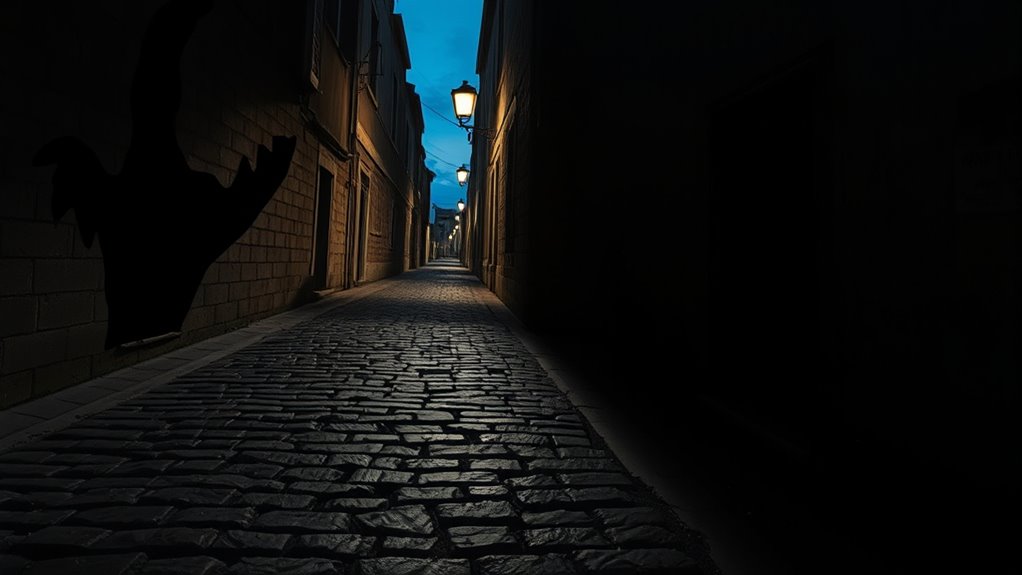
Your brain constantly searches for familiar patterns in shadows and shapes, helping you make quick judgments about your environment. This process is rooted in evolution, as recognizing threats like predators or dangers enhances survival chances. Cognitive biases can influence how you interpret ambiguous forms, sometimes leading you to see faces or objects where none exist.
Visual Pattern Recognition
Our brains are remarkably skilled at making sense of complex visual information, especially when it comes to shadows and shapes. You rely on neural pathways that quickly connect visual cues to familiar patterns, enabling rapid recognition. Sensory adaptation helps you filter out constant, unchanging shadows, so your brain remains alert to new shapes or movements. This process allows you to interpret ambiguous shadows as familiar objects or faces, even when details are obscured. To illustrate, consider how your mind might see a face in a shadowed corner or a figure in the clouds. Here’s a simple comparison:
| Pattern Recognition Aspect | Example |
|---|---|
| Neural pathways | Connecting shadows to faces |
| Sensory adaptation | Ignoring static shadows over time |
This synergy helps you interpret shadows instinctively, fueling pareidolia’s fascinating illusions.
Evolutionary Threat Detection
Shadows and ambiguous shapes often signal potential threats to the brain, triggering rapid threat detection responses rooted in evolution. Your brain quickly interprets these cues through neural adaptation, enhancing sensitivity to shadows that resemble predators or danger. Sensory sharpening helps you detect subtle changes in shapes and movements, making you more alert to potential threats. This heightened state allows your nervous system to respond swiftly, often before conscious thought occurs. Over time, this process has been fine-tuned, favoring quick reactions over cautious deliberation. Your brain’s ability to rapidly assess shadows and ambiguous shapes is an adaptive survival mechanism, ensuring you stay alert to possible dangers lurking in your environment. This instinctive threat detection underpins many pareidolic experiences, especially in low-light conditions.
Cognitive Bias Effects
Because the brain is wired to prioritize threat detection, it tends to interpret ambiguous shapes and shadows as potential dangers, even when they are harmless. This cognitive bias leads you to see familiar forms in random patterns, creating visual illusions that trigger fear or curiosity. Your mind distorts shadows into figures that seem alive or threatening, a common cognitive distortion. To better understand this, consider the table below:
| Real Shape | Perceived Shape |
|---|---|
| Tree branch shadows | A lurking figure |
| Cloud formations | Ghostly faces |
| Random patterns | Hidden eyes or monsters |
This bias explains why shadows often appear as faces or figures—your brain fills in the gaps, sometimes creating false alarms that fuel pareidolia.
The Role of Fear and Imagination in Perceiving the Supernatural

Fear and imagination work together to shape how you perceive the supernatural, often transforming ambiguous stimuli into ghostly apparitions or mysterious figures. Your superstitious beliefs and cultural influences heavily shape these perceptions, fueling your fears and imagination. When shadows flicker or sounds are uncertain, your mind fills in the gaps with supernatural explanations, amplifying feelings of dread. Cultural stories and traditions reinforce these perceptions, making it easier for your mind to interpret unfamiliar stimuli as supernatural phenomena. Fear heightens your sensitivity to ambiguous cues, leading you to see what you expect or dread. This interplay between fear, imagination, and cultural context creates a powerful tendency to perceive ghosts or spirits where there is none, reinforcing beliefs and fueling the cycle of pareidolia in the supernatural domain.
Frequently Asked Questions
Can Pareidolia Lead to False Supernatural Beliefs?
Yes, pareidolia can lead you to false supernatural beliefs because perception illusions trick your mind into seeing patterns or faces where none exist. Your cognitive biases make you more prone to interpret ambiguous stimuli as supernatural entities. When you notice shadows or noises, your brain fills in gaps, reinforcing these beliefs. Recognizing these tendencies helps you understand that what you perceive may not always reflect reality, reducing unwarranted fears.
How Does Culture Influence What Images We See?
Ah, the delightful dance of cultural symbolism shaping your visual interpretation! You see, your background colors what images jump out at you in shadows, turning vague shapes into meaningful symbols. It’s not just pareidolia; it’s your culture whispering secrets through shadows. So, whether it’s a ghost or a face, your cultural lens determines what you perceive — proving that our minds are as much shaped by society as by the shadows themselves.
Are Children More Prone to Pareidolia Than Adults?
You might notice children are more prone to pareidolia because their visual perception and childhood development are still maturing. As they grow, their brains learn to distinguish real objects from illusions. During early childhood, their imaginations are vivid, making it easier to see patterns or faces in shadows and clouds. So yes, kids tend to experience pareidolia more frequently, reflecting their ongoing development in interpreting visual stimuli.
Can Pareidolia Be Trained or Reduced?
Did you know that about 60% of people can considerably reduce pareidolia with practice? To do so, you can engage in visual training exercises that sharpen your perception and mindfulness exercises that increase awareness of your thoughts and perceptions. These methods help you recognize when your brain is creating patterns, allowing you to control or minimize pareidolia’s effects. With consistent effort, you can train your mind to see the world more clearly.
Is Pareidolia Linked to Mental Health Conditions?
You might wonder if pareidolia is linked to mental health conditions. It can be, as psychological implications suggest that frequent false perceptions may indicate underlying issues like anxiety or schizophrenia. Recognizing this connection helps avoid diagnostic challenges, ensuring mental health professionals consider pareidolia’s role in perception. While common, it’s essential to assess how it impacts an individual’s mental well-being, especially when it becomes persistent or distressing.
Conclusion
Next time you catch a shadow flicker, remember it’s your mind’s way of finding familiar faces in the darkness. Like a whisper of shapes dancing on the wall, pareidolia turns vague shadows into ghostly figures, fueled by your fears and imagination. You see a face where there’s only darkness, revealing how your brain seeks certainty in ambiguity. Embrace the shadows—they’re simply stories your mind loves to tell in the quiet of the night.
